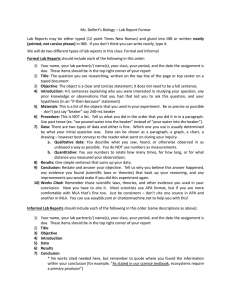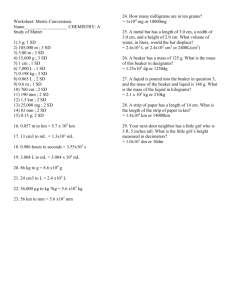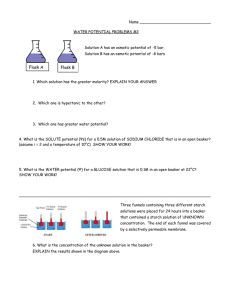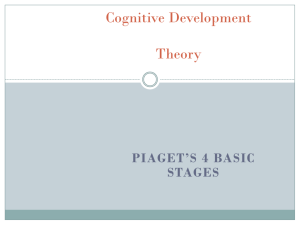Mystery Matter About this Demonstration Public Outreach
advertisement
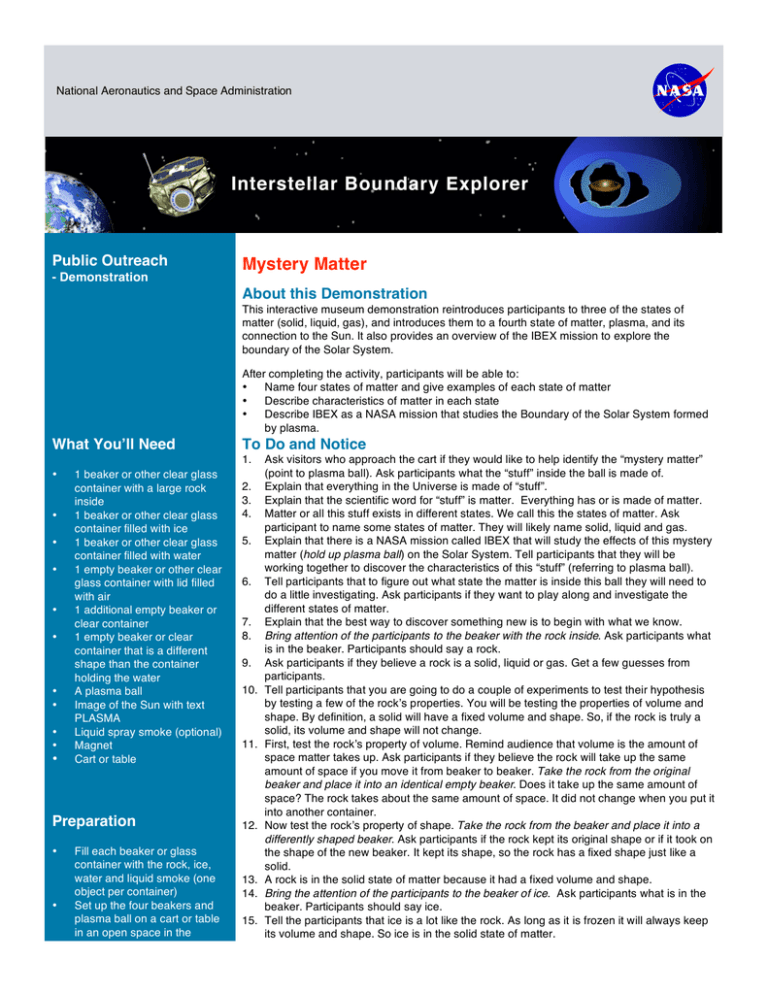
National Aeronautics and Space Administration Public Outreach - Demonstration Mystery Matter About this Demonstration This interactive museum demonstration reintroduces participants to three of the states of matter (solid, liquid, gas), and introduces them to a fourth state of matter, plasma, and its connection to the Sun. It also provides an overview of the IBEX mission to explore the boundary of the Solar System. After completing the activity, participants will be able to: • Name four states of matter and give examples of each state of matter • Describe characteristics of matter in each state • Describe IBEX as a NASA mission that studies the Boundary of the Solar System formed by plasma. What Youʼll Need To Do and Notice 1. • • • • • • • • • • • 1 beaker or other clear glass container with a large rock inside 1 beaker or other clear glass container filled with ice 1 beaker or other clear glass container filled with water 1 empty beaker or other clear glass container with lid filled with air 1 additional empty beaker or clear container 1 empty beaker or clear container that is a different shape than the container holding the water A plasma ball Image of the Sun with text PLASMA Liquid spray smoke (optional) Magnet Cart or table Preparation • • Fill each beaker or glass container with the rock, ice, water and liquid smoke (one object per container) Set up the four beakers and plasma ball on a cart or table in an open space in the 2. 3. 4. 5. 6. 7. 8. 9. 10. 11. 12. 13. 14. 15. Ask visitors who approach the cart if they would like to help identify the “mystery matter” (point to plasma ball). Ask participants what the “stuff” inside the ball is made of. Explain that everything in the Universe is made of “stuff”. Explain that the scientific word for “stuff” is matter. Everything has or is made of matter. Matter or all this stuff exists in different states. We call this the states of matter. Ask participant to name some states of matter. They will likely name solid, liquid and gas. Explain that there is a NASA mission called IBEX that will study the effects of this mystery matter (hold up plasma ball) on the Solar System. Tell participants that they will be working together to discover the characteristics of this “stuff” (referring to plasma ball). Tell participants that to figure out what state the matter is inside this ball they will need to do a little investigating. Ask participants if they want to play along and investigate the different states of matter. Explain that the best way to discover something new is to begin with what we know. Bring attention of the participants to the beaker with the rock inside. Ask participants what is in the beaker. Participants should say a rock. Ask participants if they believe a rock is a solid, liquid or gas. Get a few guesses from participants. Tell participants that you are going to do a couple of experiments to test their hypothesis by testing a few of the rockʼs properties. You will be testing the properties of volume and shape. By definition, a solid will have a fixed volume and shape. So, if the rock is truly a solid, its volume and shape will not change. First, test the rockʼs property of volume. Remind audience that volume is the amount of space matter takes up. Ask participants if they believe the rock will take up the same amount of space if you move it from beaker to beaker. Take the rock from the original beaker and place it into an identical empty beaker. Does it take up the same amount of space? The rock takes about the same amount of space. It did not change when you put it into another container. Now test the rockʼs property of shape. Take the rock from the beaker and place it into a differently shaped beaker. Ask participants if the rock kept its original shape or if it took on the shape of the new beaker. It kept its shape, so the rock has a fixed shape just like a solid. A rock is in the solid state of matter because it had a fixed volume and shape. Bring the attention of the participants to the beaker of ice. Ask participants what is in the beaker. Participants should say ice. Tell the participants that ice is a lot like the rock. As long as it is frozen it will always keep its volume and shape. So ice is in the solid state of matter. museum, preferably near a model of the Sun or information about the IBEX mission Assessment Finish the demonstration by asking questions that assess whether participants can do the following: • • • Name four states of matter Describe characteristics of matter in each state Describe IBEX as a NASA mission that studies the Boundary of the Solar System formed by plasma 16. Hold up the beaker of ice. Ask participants what would happen if we were to add heat to the ice what would happen? 17. Bring the attention of the participants to the beaker of water. Ask participants what is in the beaker. Participants should say water. 18. Ask participants if they believe water is a solid, liquid or gas. Get a few guesses from the audience. 19. Tell participants you are going to continue doing experiments. You will now testing a few of waterʼs properties. You will again test the properties of volume and shape. By definition a liquid has a fixed volume, but does not have a fixed shape. So, if water is a liquid it will always take up the same amount of space, but can change shape. 20. First you will test the waterʼs property of volume. Remind audience that volume is the amount of space matter takes up. Ask participants if they believe water will always take up the same amount of space. Pour the entire beaker of water into an identical empty beaker. It takes up the same amount of space, so water has a fixed volume because it always takes up the same amount of space. 21. Now you will test the waterʼs property of shape. Pour water from the beaker into a different shaped beaker. Does water keep the shape of the original beaker or does it take on the shape of the new beaker. It changes shape, so it doesnʼt have a fixed shape. 22. Hold up the beaker of water. Ask participants what would happen if we were to add heat to water what would happen? What state of matter would water become? 23. Bring the attention of the participants to the beaker full of liquid smoke. Ask participants what is in the beaker. Participants might say a cloud or smoke. Explain that when you heat water up, it would turn into water vapor. Tell participants that we will be using liquid smoke to represent water vapor in our demonstration. Water vapor can be difficult to see, so we have substituted it for liquid smoke just for demonstration purposes. 24. Ask participants if they believe water vapor is a solid, liquid or gas. Get a few guesses from the audience. 25. Tell participants that just as you tested a rock and waterʼs properties of shape and volume you are going to test water vaporʼs properties against the definition of a gas. By definition a gas does not have a fixed shape or a fixed volume. 26. Now, test water vaporʼs properties of volume and shape. Remind audience that volume is the amount of space matter takes up. Ask participants if they believe water vapor will take up the same amount of space if you move it from beaker to beaker. Pour the entire beaker of water vapor into an identical empty beaker. Does it take up the same amount of space? It doesnʼt because water vapor is moving in or out of the beaker, constantly changing, never taking up the same amount of space or keeping the same shape. So water vapor doesnʼt have a fixed volume or a fixed shape just like a gas. 27. Water vapor is in the gas state of matter because it doesnʼt have a fixed volume or shape. 28. Ask a participant to touch a finger to the plasma ball. Ask them to describe what happens. (The plasma seems attracted to the finger.) Ask them if this is similar to anything they have experienced (they may say like magnets are attracted to one another or a shock is attracted to my finger on a dry winter day). Ask them to try touching the container with the gas, to see if it is attracted in the same way (No.) Also recommend touching a magnet to the plasma ball and gas container. Ask if the mystery matter is the same as the gas? Tell them that plasma is similar to a gas, but it has electric and magnetic interactions that are different than gas. 29. In a solid, the atoms are tightly bound together. Solids have a fixed volume and shape. Adding energy, like heat, to a solid will often cause it to change to a liquid. Liquids have atoms that are less tightly bonded together. They have a fixed volume, but not a fixed shape. Adding heat energy to a liquid will often transform it to a gas. Gasses have neither a fixed volume nor a fixed shape. Their atoms are not bonded together and they move around freely. 30. When heat energy is added to a gas, it begins to move around faster. When enough heat energy is added to a gas it can become a plasma. 31. So our mystery matter is a plasma. 32. The Sun is mostly made of two elements, called Hydrogen and Helium, in a state of matter called plasma. 33. Hold up a picture of the Sun labeled PLASMA 34. NASAʼs IBEX mission is studying the Sun and its influence on our Solar System. The Sunʼs plasma flows to help form a boundary that protects our Solar System from the rest of space. NASAʼs IBEX mission will be studying the boundary of our Solar System. Activity Notes A possible variation to this activity is for the facilitator to put Mystery Matter! Lesson plan into the context of a game show. Related Websites & Resources NASAʼs IBEX mission page discusses plasma for a general audience. http://www.ibex.swri.edu Space Weather Center has a educational sorting for sates of matter. http://www.spaceweathercenter.org/amazing_plasmas/01/mattersorter.html The Coalition for Plasma Science has educational publications about plasma. http://www.plasmacoalition.org/edmaterials.htm Roses Theatrical Supply has a supply of liquid spray smoke to purchase. www.theatricalshop.com/rosesweb/spray_smoke.htm Cool Stuff Cheap has a supply of plasma balls to purchase. www.coolstuffcheap.com/8plasbal.html Additional At-Home Activity Participants of the Mystery Matter demonstration may extend their learning at home by completing a Family States of Matter Chart. As a family, participants can explore states of matter together by identifying different sates of matter as they observe the world around them. Family States of Matter Chart Explore states of matter at home! What different states of matter do you observe in the world around you? In the chart below, record: • The date and time you observed the state of matter. • Does the object you observe always keep its shape? • Does the object you observe always take up the same amount of space? • What is the objectʼs state of matter? You can compare your observations to the states of matter definitions below. Date/Time Name of object you observe Does it always keep its shape? Does it always take up the same amount of space? Does it have electric or magnetic interactions? What is its state of matter? A solid has a fixed volume and shape. So, for something to be a solid, its volume (the space it takes up), and its shape will not change. A liquid has a fixed volume, but does not have a fixed shape. So, for something to be a liquid, its volume (the space it takes up) will not change, but its shape will change. A gas does not have a fixed volume or shape. So, for something to be a gas, its volume (the space it takes up), as well as its shape will change. www.nasa.gov A plasma is similar to a gas and does not have a fixed volume or shape (like a gas), but it does have electric and magnetic interactions.

